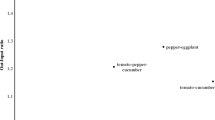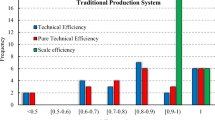Abstract
Increasing crop production usually warrants increased use of energy in the system that triggers the question of locating an ‘appropriate’ operating point by weighing the economics of output and its environmental impacts. Sustainability of diverse cereals, legumes and vegetable production systems were assessed in lowlands of Nepal in light of the efficiency of energy use, CO2e (carbon dioxide equivalent) emissions and financial return–cost ratios. The energy saving potential of 238 farms selected in the study area is calculated adopting Data Envelopment Analysis (DEA). Based on the per-hectare energy consumption, vegetables (12.37 GJ), cereals (10.60 GJ) and legumes (3.80 GJ) crop production systems are ranked in descending order. Rice offered the highest per-hectare energy output (68.99 GJ) among the selected crops. Potential saving of energy inputs in the study area is shown to be between 18 and 35% without conceding yield of the particular crop production system. The highest environmental impact is due to garlic production (2997.13 kg CO2e ha−1); while rice, maize, wheat, lentil, mungbean and onion crops emit 60, 63, 28, 5, 3 and 86% CO2e emissions (of that of garlic crop), respectively. As expected, the vegetable production remains the most profitable system with the return–cost ratio of 2.96–3.52, followed by legume (1.83–2.16) and cereal (1.21–1.96) production systems.



Similar content being viewed by others
References
Arora NK (2018) Environmental Sustainability-necessary for survival. Environ Sust 1:1–2
Arora NK, Fatima T, Mishra I, Verma M, Mishra J, Mishra V (2018) Environmental sustainability: challenges and viable solutions. Environ Sust 1:309–340
Banker RD, Charnes A, Cooper WW (1984) Some models for estimating technical and scale in efficiencies in data envelopment analysis. Manag Sci 30:1078–1092
Chauhan NS, Mohapatra PKJ, Pandey KP (2006) Improving energy productivity in paddy production through benchmarking: an application of data envelopment analysis. Energy Conv Manag 47:1063–1085
Cooper WW, Seiford LM, Tone K (2007) Data envelopment analysis: a comprehensive text with models, applications, references and DEA-Solver software, 2nd edn. Springer, New York
Dyer JA, Desjardins RL (2006) Carbon dioxide emissions associated with the manufacturing of tractors and farm machinery in Canada. Biosyst Eng 93:107–118
Elsoragaby S, Yahya A, Mahadi MR, Nawi NM, Mairghany M (2019) Energy utilization in major crop cultivation. Energy 173:1285–1303
FAOSTAT (2019) Data. http://www.fao.org/faostat/en/#data. Accessed 24 Apr 2019
IPCC (2006) IPCC guidelines for national greenhouse gas inventories. https://www.ipcc-nggip.iges.or.jp/public/2006gl/vol4.html. Accessed 11 Sept 2018
Juarez-Hernandez S, Uson S, Pardo CS (2019) Assessing maize production systems in Mexico from an energy, exergy, and greenhouse-gas emissions perspective. Energy 170:199–211
Khoshnevisan B, Rafiee S, Omid M, Mousazadeh H (2013) Applying data envelopment analysis approach to improve energy efficiency and reduce GHG (greenhouse gas) emission of wheat production. Energy 58:588–593
Koocheki A, Ghorbani R, Mondani F, Alizade Y, Moradi R (2011) Pulses production systems in term of energy use efficiency and economical analysis in Iran. Int J Energy Econ Policy 1:95–106
Maraseni TN, Cockfield G (2012) Including the costs of water and greenhouse gas emissions in a reassessment of the profitability of irrigation. Agric Water Manag 103:25–32
MESD (2018) Statistical information on Nepalese agriculture 2016/2017. Government of Nepal, Ministry of Agriculture, Land Management and Cooperatives, Monitoring, Evaluation and Statistics Division, Agriculture Statistics Section, Singhdurbar, Kathmandu, Nepal
Mondani F, Aleagha S, Khoramivafa M, Ghobadi R (2017) Evaluation of greenhouse gases emission based on energy consumption in wheat Agroecosystems. Energy Rep 3:37–45
Nasseri A (2019) Energy use and economic analysis for wheat production by conservation tillage along with sprinkler irrigation. Sci Total Environ 648:450–459
Nassiri SM, Singh S (2009) Study on energy use efficiency for paddy crop using data envelopment analysis (DEA) technique. Appl Energy 86:1320–1325
Pokhrel A, Soni P (2017) Performance analysis of different rice-based cropping systems in tropical region of Nepal. J Environ Manag 197:70–79
Pokhrel A, Soni P (2018) An investigation into a resource and environmentally sustainable system: zero-tillage lentil and garlic production in Nepal. Agroecol Sustain Food Syst 42:982–1002
Pokhrel A, Soni P (2019) Energy balance and environmental impacts of rice and wheat production: a case study in Nepal. Int J Agric Biol Eng 12(201):207
Prasad SK, Pullabhotla H, Ganesh-Kumar A (2011) Supply and demand for cereals in Nepal, 2010–2030. http://ebrary.ifpri.org/cdm/ref/collection/p15738coll2/id/12494. Accessed 12 Jan 2018
Ramsden SJ, Wilson P, Phrommarat B (2017) Integrating economic and environmental impact analysis: the case of ricebased farming in northern Thailand. Agric Syst 157:1–10
Saad AA, Das TK, Rana DS, Sharma AR, Bhattacharyya R, Lal K (2016) Energy auditing of a maize-wheat-greengram cropping system under conventional and conservation agriculture in irrigated north-western Indo-Gangetic Plains. Energy 116:293–305
Samavatean N, Rafiee S, Mobli H, Mohammadi A (2011) An analysis of energy use and relation between energy inputs and yield, costs and income of garlic production in Iran. Renew Energy 36:1808–1813
Soni P, Taewichit C, Salokhe VM (2013) Energy consumption and CO2 emissions in rainfed agricultural production systems of Northeast Thailand. Agric Syst 116:25–36
Taki M, Soheili-Fard F, Rohani A, Chen G, Yildizhan H (2018) Life cycle assessment to compare the environmental impacts of different wheat production systems. J Clean Prod 197:195–207
WECS (2010) Energy sector synopsis report 2010. Water and Energy Commission Secretariat, Kathmandu
World Bank (2017) Indicators. http://data.worldbank.org/indicator. Accessed 24 Sept 2017
Yodkhum S, Sampattagul S, Gheewala SH (2018) Energy and environmental impact analysis of rice cultivation and straw management in northern Thailand. Environ Sci Pollut Res. https://doi.org/10.1007/s11356-018-1961-y
Yuan S, Peng S, Wang D, Man J (2018) Evaluation of the energy budget and energy use efficiency in wheat production under various crop management practices in China. Energy 160:184–191
Zarini RL, Akram A, Kolour RT, Firouzjaee RA (2014) Energy use, economic analysis and mechanization index of onion production in Iran. J Middle East Appl Sci Technol 1:344–351
Acknowledgements
The authors gratefully acknowledge necessary support received from Agricultural Learning Exchanges in Asian Regional Networking (AgLEARN) project of the USAID/RDMA and Asian Institute of Technology (AIT), Thailand. Cooperation of the farmers during field survey and data collection is thankfully appreciated.
Author information
Authors and Affiliations
Corresponding author
Additional information
Publisher's Note
Springer Nature remains neutral with regard to jurisdictional claims in published maps and institutional affiliations.
Rights and permissions
About this article
Cite this article
Pokhrel, A., Soni, P. Sustainability assessment of crop production in accord with energy, environment and economic performances in Nepal. Environmental Sustainability 2, 343–353 (2019). https://doi.org/10.1007/s42398-019-00076-y
Received:
Revised:
Accepted:
Published:
Issue Date:
DOI: https://doi.org/10.1007/s42398-019-00076-y




